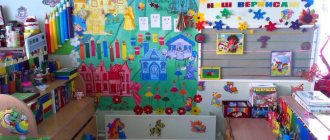Developmental learning technologies for preschoolers
Olga Kamartdinova
Developmental learning technologies for preschoolers
DEVELOPMENTAL EDUCATION TECHNOLOGIES FOR PRESCHOOL CHILDREN
CONTENT
Introduction...3
1. Modern stages of development of Russia… . 4
2. Pedagogical technologies… . 4
3. The concept of “game pedagogical technologies ”
…5
4. Problem-based learning technology...8
5. The basis of developmental learning technologies...9
6. Information technologies in pedagogy… . 10
7. Technology of educational games B. P. Nikitina….11
Conclusion….13
List of used literature... 15
Introduction
The process of reorganization of the entire education system, which has been going on for many years, places high demands on the organization of preschool education and training , and intensifies the search for new, more effective psychological and pedagogical approaches to this process.
Innovative processes at the present stage of development of society primarily affect the system of preschool education , as the initial stage in revealing the potential abilities of a child. The development of preschool education and the transition to a new qualitative level cannot be carried out without the development of innovative technologies [ 1,24].
Innovation determines new methods, forms, means, technologies used in pedagogical practice, focused on the child’s personality and the development of his abilities .
1. Modern stages of development of Russia
At the present stage of development of Russia, changes are taking place in educational processes: the content of education is becoming more complex, focusing the attention of preschool teachers on the development of the creative and intellectual abilities of children, correction of the emotional-volitional and motor spheres; Traditional methods are being replaced by active methods of teaching and upbringing aimed at enhancing the child’s cognitive development . In these changing conditions, a preschool needs to be able to navigate the variety of integrative approaches to child development , and a wide range of modern technologies [2,132 ].
Innovative technologies are a system of methods, methods, teaching , educational tools aimed at achieving a positive result through dynamic changes in the personal development of a child in modern sociocultural conditions. Pedagogical innovations can either change the processes of education and training , or improve them. Innovative technologies combine progressive creative technologies and stereotypical elements of education that have proven their effectiveness in the process of teaching.
The following reasons for the emergence of innovations in preschool education : scientific research; sociocultural environment - the need of preschool educational institutions for new pedagogical systems; creative variability of teachers; parents' interest in achieving positive dynamics in the development of children [3,44 ].
2. Pedagogical technologies
The concept of pedagogical technology includes :
conceptual framework;
content of training ( learning and content of educational material)
;
technological part (organization of the educational process, methods and forms of educational activities, methods and forms of teacher work; diagnostics).
According to G.K. Selevko, any pedagogical technology must satisfy some basic methodological requirements manufacturability criteria )
[2,243].
Conceptuality presupposes reliance on a certain scientific concept, including philosophical, psychological, didactic and socio-pedagogical justification for achieving educational goals.
Consistency includes the presence of all the features of the system: the logic of the process, the interconnection of all its parts, integrity.
Controllability makes it possible for diagnostic goal setting, planning, design of the learning , step-by-step diagnostics, varying means and methods in order to correct results.
Efficiency considers optimality in terms of costs, a guarantee of achieving a certain standard of training .
Reproducibility implies the possibility of application (repetition, reproduction)
pedagogical
technology in other similar educational institutions, by other subjects.
Based on the analysis of pedagogical technologies carried out by G. N. Selevko, the following technologies used in the preschool education : developmental learning technologies , problem-based learning , gaming technologies , computer technologies , alternative technologies .
3. The concept of “game pedagogical technologies ”
The concept of “game pedagogical technologies ”
includes a fairly extensive group of methods and techniques for organizing the pedagogical process in the form of various pedagogical games.
Unlike games in general, a pedagogical game has an essential feature - a clearly defined learning and a corresponding pedagogical result, which can be justified, identified explicitly and characterized by a cognitive orientation.
The game form of classes is created by game motivation, which acts as a means of inducing and stimulating children to educational activities [4,243].
The implementation of gaming techniques and situations in the classroom takes place in the following main areas:
a didactic goal is set for children in the form of a game task;
educational activities are subject to the rules of the game;
educational material is used as its means;
an element of competition is introduced into educational activities, which transforms a didactic task into a game one;
successful completion of a didactic task is associated with the game result.
The place and role of gaming technology in the educational process , the combination of game and learning elements largely depend on the teacher’s understanding of the functions and classification of pedagogical games.
Based on the nature of the pedagogical process, the following groups are distinguished:
teaching , training, controlling and generalizing;
cognitive, educational, developmental ;
reproductive, productive, creative;
communicative, diagnostic, psychotechnical, etc.
The specifics of gaming technology are largely determined by the gaming environment: there are games with and without objects, board-print games; indoor, outdoor, on the ground, computer and with TSO, as well as with various means of transportation.
The psychological mechanisms of gaming activity are based on the fundamental needs of the individual for self-expression, self-affirmation, self-regulation, and self-realization.
The content of children's games develops sequentially : objective activity, relationships between people, compliance with the rules of social behavior.
The purpose of gaming technologies is to solve a number of problems:
didactic (broadening horizons, cognitive activity; formation of certain skills and abilities necessary in practical activities, etc.);
developing ( development of attention , memory, speech, thinking, imagination, fantasy, creative ideas, skills to establish patterns, find optimal solutions, etc.);
educating (nurturing independence, will, formation of moral, aesthetic and ideological positions, nurturing cooperation, collectivism, sociability, etc.);
socializing (familiarization with the norms and values of society; adaptation to environmental conditions, etc.) [4,129].
Gaming technologies are widely used in preschool age , since play is the leading activity during this period. The child masters role play by the third year of life, becomes familiar with human relationships, begins to distinguish between the external and internal aspects of phenomena, discovers the presence of experiences and begins to navigate them.
The child’s imagination and symbolic function of consciousness are formed, which allow him to transfer the properties of some things to others, orientation in his own feelings arises and skills of their cultural expression are formed, which allows the child to be involved in collective activities and communication.
As a result of mastering play activities in the preschool period, readiness for socially significant and socially valued learning activities is formed.
4. Problem-based learning technology
The technology of problem-based learning is based on the theoretical principles of the American philosopher, psychologist and teacher D. Dewey[5,33]. Today, problem-based learning is understood as such an organization of educational activities that involves the creation, under the guidance of a teacher, of problem situations and the active independent activity of students to resolve them, as a result of which the creative mastery of professional knowledge, skills, abilities and the development of thinking abilities occurs.
The goal of problem technology is the acquisition of knowledge, mastering methods of independent activity, and the development of cognitive and creative abilities.
Problem-based learning is based on the creation of a special type of motivation - problem-based, and therefore requires adequate construction of the didactic content of the material, which should be presented as a chain of problem situations.
Problem situations can be different in the content of the unknown, in the level of problem, in the type of information mismatch, and in other methodological features.
Problem-based methods are methods based on the creation of problem situations, active cognitive activity of students, consisting in searching and solving complex issues that require updating knowledge, analysis, and the ability to see a phenomenon or law behind individual facts.
In the modern theory of problem-based learning, two types of problem situations are distinguished: psychological and pedagogical. The first concerns the activities of students, the second represents the organization of the educational process.
A pedagogical problem situation is created with the help of activating actions, questions from the teacher, emphasizing the novelty, importance, beauty and other distinctive qualities of the object of knowledge. The creation of a psychological problem situation is purely individual. Neither a cognitive task that is too difficult nor a cognitive task that is too easy creates a problematic situation for children. Problem situations can be created at all stages of the learning : during explanation, reinforcement, control.
5. The basis of developmental learning technologies
Developmental learning technologies are based on that originates in the works of I. G. Pestalozzi, K. D. Ushinsky and others [4,235]. The theory was scientifically substantiated in the works of L. S. Vygotsky, who put forward the idea of learning that goes ahead of development and is focused on the development of the child as the main goal. According to his hypothesis, knowledge is not the ultimate goal of learning , but merely a medium for student development .
The ideas of L. S. Vygotsky were developed and substantiated within the framework of the psychological theory of activity by A. N. Leontiev, P. Ya. Galperin, etc.). As a result of the revision of traditional ideas about development and its relationship with learning , the formation of the child as a subject of various types of human activity was brought to the fore [6,87].
its further development in the experimental works of L. V. Zankov, D. B. Elkonin, V. V. Davydov and others.
In their concepts, training and development appear as a system of dialectically interconnected aspects of one process. Education is recognized as the driving force behind a child’s mental development and the development of the entire range of personality traits. Currently, within the framework of the concept of developmental education, a number of technologies have been developed that differ in target orientations, features of content and methodology.
Developmental learning , according to V.V. Davydov, is understood as a new, active-activity method (type)
of learning , replacing the explanatory-illustrative method (type)
[5,33].
In the technology of developmental education, the child is assigned the role of an independent subject interacting with the environment. This interaction includes all stages of activity: goal setting, planning and organization, implementation of goals, analysis of performance results. Developmental education is aimed at developing the entire complex of personality qualities.
Developmental learning occurs in the child's zone of proximal development . L. S. Vygotsky wrote: “Pedagogy should focus not on yesterday, but on tomorrow’s child development .” He identified two levels in child development : 1) sphere (level)
actual
development - already formed qualities and what the child can do independently; 2) zone of proximal development - those types of activities that the child is not yet able to perform independently, but which he can cope with with the help of adults [7,97].
The zone of proximal development is a greater or lesser opportunity to move from what a child can do independently to what he can do in cooperation.
An essential feature of developmental education is that it creates a zone of proximal development , evokes, encourages, and sets in motion the internal processes of mental formations.
6. Information technologies in pedagogy
Information technologies in teaching pedagogy refer to all technologies that use special technical information tools (computers, audio, video)
.
Computers began to be widely used in education, and the term “computer
education technology ” .
Computer technologies are developing the ideas of programmed learning , opening up completely new, not yet explored technological options associated with the unique capabilities of modern computers and communications. Computer (new information) teaching technologies are the processes of preparing and transmitting information to the learner via a computer.
The purpose of computer technology is to develop the ability to work with information, develop communication abilities, and prepare the personality of the “information society”
, formation of research skills, abilities to make optimal decisions.
In a broad sense, alternative technologies are usually considered to be those that oppose the traditional teaching in some way, be it goals, content, forms, methods, relationships, positions of participants in the pedagogical process. From this point of view, any innovation can claim the status of an alternative technology .
Alternative technologies involve abandoning both the traditional conceptual foundations of the pedagogical process (socio-philosophical, psychological, generally accepted organizational, substantive and methodological principles, and replacing them with other, alternative ones.
7. Technology of educational games B. P. Nikitina
The game activity program consists of a set of educational games , which, with all their diversity, are based on a general idea and have characteristic features.
Each game is a set of problems that the child solves with the help of cubes, bricks, squares made of cardboard or plastic, parts from a mechanical designer, etc. In his books, B. P. Nikitin offers educational games with cubes , patterns, frames and Montessori inserts, unicube, plans and maps, squares, “Guess”
, hundreds of tables,
“dots”
,
“clocks”
, thermometer, bricks, cubes, constructors.
Children play with balls, ropes, rubber bands, pebbles, nuts, corks, buttons, sticks, etc., etc. Subject-based educational games are the basis of construction, labor and technical games and are directly related to intelligence.
Tasks are given to the child in various forms: in the form of a model, a flat isometric drawing, a drawing, written or oral instructions, etc., and thus introduce him to different ways of transmitting information.
The tasks have a very wide range of difficulties: from those that are sometimes accessible to a two or three year old child to those that are beyond the capabilities of the average adult. Therefore, games can excite interest for many years (until adulthood)
.
A gradual increase in the difficulty of tasks in games allows the child to move forward and improve independently, that is, to develop his creative abilities, in contrast to education , where everything is explained and where, basically, only the performing traits in the child are formed.
The solution to the problem appears before the child not in the abstract form of the answer to a logical problem, but in the form of a drawing, pattern or structure made of cubes, parts of a construction set, i.e. in the form of visible and tangible things. This allows you to visually compare the “task”
with
the “solution”
and check the accuracy of the task yourself[8,23].
In educational games (this is their main feature)
it is possible to combine one of the basic principles
of learning - from simple to complex - with the very important principle of creative activity independently according to ability, when a child can rise to the “ceiling”
of his capabilities.
According to B.P. Nikitin, this union made it possible to solve several problems related to the development of creative abilities in the game: educational games can provide “food”
to
develop creative abilities from a very early age; stepping stone tasks always create conditions that precede the development of abilities ; By studying independently each time up to your “ceiling”
, the child
develops most successfully .
Educational games can be very diverse in their content, like any games; they do not tolerate coercion and create an atmosphere of free and joyful creativity.
Conclusion
The work of a teacher is quite complex and varied. It predetermines the use of a large number of techniques for analyzing the personality of students, for solving problems and conflict issues.
In the work of a teacher, it is very important to be vigilant and objectively assess the situation, selecting the best methods for solving problematic issues and conflict situations.
It is necessary to pay attention to the fact that absolutely any technology of pedagogical training originates from the root causes and primary sources, which are the determining foundations of a person’s mental state. The main leading factor of development plays a fundamental role in this aspect and forms the fundamental element on which technology .
The work of a teacher is quite complex and varied. It predetermines the use of a large number of techniques for analyzing the personality of students, for solving problems and conflict issues.
In the work of a teacher, it is very important to be vigilant and objectively assess the situation, selecting the best methods for solving problematic issues and conflict situations.
At the moment, it is difficult to underestimate the importance of play in a child’s life, because only through play does a child learn to understand the world around him, develop his cognitive skills, generally speaking, learn to develop his social skills through role-playing game performances. The game forms the imagination and teaches the child all-round development and the ability to feel and perceive emotionally the foundations of social life.
the correct choice of pedagogical means, which, on the one hand, help the child to internalize social norms, on the other hand, to realize himself and, accordingly, determine his individual way of behavior in the social structure.
List of used literature
1. Atemaskina Yu. V. Bogoslovets L. G. Modern pedagogical technologies in preschool educational institutions . - St. Petersburg: Publishing house "Childhood-Press"
. - 2015. - P. 89.
2. Atutov P. R. Technology and modern education / P. R. Atutov // Pedagogy. - 2014. - No. 2. - P. 236.
3. Belkin A. S. Vitagenic training with the holographic method of projections / A. S. Belkin // School technologies . - 2014. - No. 3.
4. Bespalko V. P. Pedagogy and progressive teaching technologies / V. P. Bespalko. - M., 2014.- P. 287.
5. Bulanova - Toporkova M.V., Dukhavneva A.V. et al. Pedagogical technologies . — Rostov n/d: publishing house
, 2012.- P. 47.
6. Guzeev V.V. Educational technology : from reception to philosophy, - M.: September. — 2016.- P. 156.
7. Davydov V.V. “Problems of developmental education ”
Moscow,
“Enlightenment”
, 2011
8. Kirillova G. D. “Theory and practice of the lesson in the conditions of developmental education ” Moscow, “Enlightenment”
, 1980
9. Clarin M. V. Innovations in world pedagogy / M. V. Clarin. - Riga Experiment, 2015 - P. -478.
10. Ksenzova G. Yu. Advanced school technologies : - M.: Pedagogical Society of Russia, 2014. - P. 214.
11. Kudryavtsev V. T. Problem-based learning : origins, essence of perspective / V. T. Kudryavtsev. - M.: Knowledge, 2015.- P. 26.
12. Kukushkin V. S. Modern pedagogical technologies . Elementary School. Teacher's manual. — Rostov n/a: publishing house "Phoenix"
, 2013.- pp. 59-64



